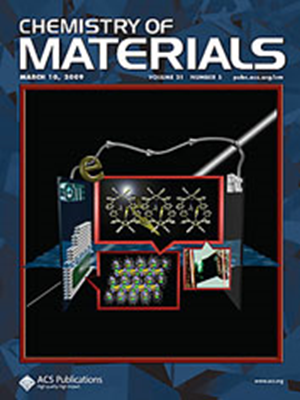从磁链到薄片:温和水热合成中氢氟酸量对混合金属氟形成的影响
IF 7
2区 材料科学
Q2 CHEMISTRY, PHYSICAL
引用次数: 0
摘要
由于其广泛的结构多样性和承载大量具有大磁矩的低氧化态过渡金属的能力,混合金属氟化物是几何挫折磁性材料的优秀候选者。利用温和水热合成路线,生长出通式为MIIM2IIIF8(H2O)2 (MII = Co, Mn, Ni, Cu, Zn)的一系列混合金属氟化物;讨论了MIII = Cr和V),以及含氟稀土CoCe2F10(H2O)2。除CuV2F8(H2O)2由于Jahn-Teller畸变在单斜晶系(C2/c)中结晶外,所有合成的MIIM2IIIF8(H2O)2氟化物均为同构(正交,Fmmm)。CoCe2F10(H2O)2在正交空间群Cmce中结晶。讨论了水热反应条件对相形成的极端敏感性,特别是HF用量如何影响特定成分和结构类型的形成。此外,还讨论了MIIM2IIIF8(H2O)2族的复合磁性行为。本文章由计算机程序翻译,如有差异,请以英文原文为准。

From Magnetic Chains to Sheets: The Impact of Hydrofluoric Acid Quantities in Mild Hydrothermal Synthesis on Mixed-Metal Fluoride Formation
Mixed-metal fluorides are excellent candidates for geometrically frustrated magnetic materials due to their extensive structural diversity and ability to host a plethora of low oxidation state transition metals with large magnetic moments. The utilization of the mild hydrothermal synthesis route to grow a series of mixed-metal fluorides with the general formula MIIM2IIIF8(H2O)2 (MII = Co, Mn, Ni, Cu, and Zn; MIII = Cr and V), as well as a rare earth containing fluoride, CoCe2F10(H2O)2, is discussed. All synthesized MIIM2IIIF8(H2O)2 fluorides were isostructural (orthorhombic, Fmmm) with the exception of CuV2F8(H2O)2, which crystallizes in the monoclinic (C2/c) crystal system due to Jahn–Teller distortions. CoCe2F10(H2O)2 crystallizes in orthorhombic space group Cmce. The extreme sensitivity of the hydrothermal reaction conditions on phase formation is discussed, in particular how the volume of HF used impacts the formation of specific compositions and structure types. In addition, the complex magnetic behavior of the MIIM2IIIF8(H2O)2 family is discussed.
求助全文
通过发布文献求助,成功后即可免费获取论文全文。
去求助
来源期刊

Chemistry of Materials
工程技术-材料科学:综合
CiteScore
14.10
自引率
5.80%
发文量
929
审稿时长
1.5 months
期刊介绍:
The journal Chemistry of Materials focuses on publishing original research at the intersection of materials science and chemistry. The studies published in the journal involve chemistry as a prominent component and explore topics such as the design, synthesis, characterization, processing, understanding, and application of functional or potentially functional materials. The journal covers various areas of interest, including inorganic and organic solid-state chemistry, nanomaterials, biomaterials, thin films and polymers, and composite/hybrid materials. The journal particularly seeks papers that highlight the creation or development of innovative materials with novel optical, electrical, magnetic, catalytic, or mechanical properties. It is essential that manuscripts on these topics have a primary focus on the chemistry of materials and represent a significant advancement compared to prior research. Before external reviews are sought, submitted manuscripts undergo a review process by a minimum of two editors to ensure their appropriateness for the journal and the presence of sufficient evidence of a significant advance that will be of broad interest to the materials chemistry community.
 求助内容:
求助内容: 应助结果提醒方式:
应助结果提醒方式:


